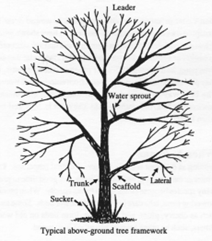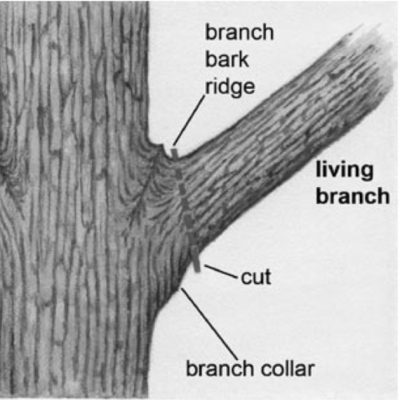Prune Now for Beautiful Summer Trees
By Marie Woodward, UConn Home & Garden Education Center

Winter is a great time for gardeners to plan for their next growing season. Many think that planning can only be done inside. Not so. Now is an ideal time to prune deciduous landscape trees. The absence of leaves gives a clear view of the canopy above and allows for a clear assessment of a tree’s structure and any problems that may be present. In addition, there are no pests present in winter, and disease spread will be slowed by the cold weather. But before heading outside with those loppers and pruning saws, there are a few important things to know and consider.
It's important to understand the tree’s anatomy. A typical deciduous landscape tree will consist of three main parts: the leader, the scaffolding branches and the lateral branches. The leader is the dominant vertical branch of the tree. This is easily spotted as the straight, most upward growth from the trunk. The leader is the tree’s most important branch, crucial for the tree’ structure, photosynthesis, and even distribution of nutrients. Scaffolding branches emerge from the trunk and the leader to make up the canopy of the tree. Secondary branches that grow from the scaffold branches are called lateral branches. Once you understand the basic structure of the tree, it’s much easier to successfully prune it.

Photo from Virginia Cooperative ExtensionFirst, assess the tree. What species of tree is it? That will reveal its natural structure, something your pruning should ideally strive to support. Note though, that proximity to buildings or human activity nearby is likely to influence your pruning strategy (keeping scaffolding branches clear of buildings, for example, or making sure people can walk under the lowest branch?)
Locate the leader of the tree and look for problem branches. Dead, diseased, damaged, or crossing branches should be pruned first. When pruning dead or diseased branches, make cuts into healthy wood, well below the affected area. It’s also a good idea to disinfect tools between cuts to help prevent the spread of disease. (A 10% solution of bleach to water works well.)
After the tree’s diseased, damaged, or crossing branches are pruned, look for lateral branches that are trying to compete vertically with the leader. They can draw energy away from the leader and sap the tree’s vigor. Usually, there is no need to remove all of a competing branch. Just pruning the vertical portion back to the scaffold branch should be sufficient. This will slow the competitor branch’s rate of growth, allowing the leader to dominate.
When pruning a scaffold branch, it is important to cut outside the branch collar. That is the swollen area at the base of the branch, where it joins the trunk. Make the cut outside the branch collar at a 45-to-60-degree angle to the trunk and leave it alone to heal naturally. There is no need to coat or cover cuts. Doing so could prevent the wound from healing and might seal in pathogens adversely affecting the health of the tree.

According to Pete Smith, forester and arborist from the Arbor Day Foundation, there are five main factors to consider when pruning trees:
- After pruning, two-thirds of the height of the tree should still have branches and leaves to keep growing in a healthy manner.
- Do not remove more than one third of the total branches in one year.
- Branches attached to the trunk should not be more than one half of the diameter of the main trunk.
- Every pruning cut should be no more than one inch in diameter
- There should be a total of five cuts in a year.
Of course, when pruning a long-neglected tree, it may take a few seasons to be able to apply all five rules, but ultimately, your trees will be healthier and more beautiful if you follow these guidelines.
For questions about pruning or if you have any other gardening questions, contact the UConn Home & Garden Education at (877) 486-6271 or http://www.homegarden.cahnr.uconn.edu/ or your local Cooperative Extension Center.